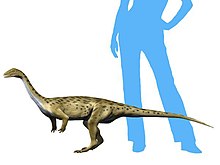Saturnaliidae
| Saturnaliids | |
|---|---|

| |
| Life restoration of Saturnalia tupiniquim | |
| Scientific classification | |
| Domain: | Eukaryota |
| Kingdom: | Animalia |
| Phylum: | Chordata |
| Clade: | Dinosauria |
| Clade: | Saurischia |
| Clade: | †Sauropodomorpha |
| Family: | †Saturnaliidae Langer et al., 2019 |
| Type species | |
| †Saturnalia tupiniquim Langer et al., 1999
| |
| Genera | |
| |
| Synonyms | |
| |
Saturnaliidae is a
dinosaurs found in Brazil, Argentina and possibly Zimbabwe.[1] It is not to be confused with Saturnalidae, a family of radiolarian protists.[2]
Classification
In 2010,
Saturnalia and Chromogisaurus, which were found to be close relatives in several studies.[1] While they are sometimes found to be a subgroup within the Guaibasauridae,[1] all recent studies have found the saturnaliines to form an independent lineage at the very base of the sauropodomorph family tree.[3][4][5][6][7][8][9] At one point, Agnosphitys was recovered as a possible saturnaliine until it was recovered as a member of Silesauridae in 2017.[10] Langer and colleagues (2019) recovered Pampadromaeus and Panphagia as relatives of Saturnalia and Chromogisaurus, elevating Saturnaliinae to family rank as Saturnaliidae. In that particular paper, they recovered Guaibasaurus as a basal theropod.[11]
Additionally, Eoraptor, Buriolestes, Bagualosaurus and especially Nhandumirim are also possible members of this clade following their position in many recent phylogenetic analyses[4][5][6][7][8][9] and the new definition given by Langer et al. (2019), as "the maximal sauropodomorph clade to encompass Saturnalia but not Plateosaurus."[11] In several of these analyses, Guaibasaurus is recovered as distantly related to Saturnalia, sometimes as a more basal sauropodomorph or saurischian, and in some cases specifically related to more derived taxa such as Macrocollum and Unaysaurus. This way a Guaibasauridae including Saturnalia and kin is no longer being supported.
References
- ^ S2CID 129244872.
- ^ "IRMNG - Saturnalidae Deflandre, 1953 †". www.irmng.org. Retrieved 2021-11-24.
- PMID 22096511.
- ^ PMID 31720108.
- ^ .
- ^ S2CID 232313141.
- ^ S2CID 229432076.
- ^ PMID 32842895.
- ^ ISSN 0024-4082.
- ^ Pampadromaeus barberenai (Saurischia—Sauropodomorpha) from the Late Triassic Santa Maria Formation of southern Brazil. PLoS ONE 14(2): e0212543. https://doi.org/10.1371/journal.pone.0212543
